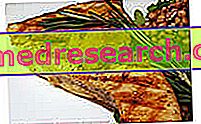Diet as a Cause of Appendicitis
The diet plays an important role in the onset of appendicitis, the dreaded inflammatory process that involves a small diverticulum, called the vermiform appendix, located in the initial part of the large intestine.

Often, this is at least a complicated relationship, where there is no scientific evidence confirmed on a large scale, and there is only timid evidence, which is why we tend to generalize by repeating the general rules of a healthy and balanced diet.
Speaking specifically of appendicitis, we know that the disease is extremely rare among the indigenous populations of tropical Africa, while it is far more common in the African-American population of the United States. Not being able to be linked to genetic differences, this phenomenon can be explained on the basis of lifestyle and environmental differences.
In this regard, the fact that:
an adequate dietary intake of fiber and a nutritional style based on sobriety and moderation of energy intake (getting up from the table with a little more hunger), helps to prevent many of the main wellness diseases that afflict Western countries, including 'appendicitis.
Food risk factors
The increased frequency of appendicitis episodes in Western countries, therefore, seems to be related - at least in part - to a generally refined diet with no waste.
Added to this is the lack of physical activity and the tendency to maintain a static position, such as sitting, for many hours a week.
From constipation to appendicitis
These habits tend to slow down the motility of the colon, increasing the retention time of the faeces in the intestine and with it the share of water reabsorbed by the fecal mass.
Therefore, the faeces become harder, more compact and difficult to evacuate.
When the fecal material accumulates in the vermiform appendix, compacting to the point of causing a local obstruction (fecaloma → deposit of inorganic salts → coprolite), it is very likely that the diverticulum becomes inflamed. The local accumulation of mucus and exudate helps to dilate the walls of the appendix, compressing, then occluding, the lymphatic and blood vessels that flow inside it; the lack of blood, together with the lymphatic stasis, favors the proliferation of germs inside the inflamed appendix, causing local necrosis until its rupture with consequent peritonitis (a very fearful complication because potentially lethal).
Diet and prevention of appendicitis
In view of a healthy and thoughtful prevention of appendicitis and other important intestinal diseases (diverticulosis, diverticulitis, colon cancer, chronic constipation, hemorrhoids, polyposis of the colon), it is advisable to learn from the rules drawn up by INRAN on the subject to the guidelines for a healthy Italian diet, with particular reference to the supply of liquids and fiber, but also to the practice of basic physical activity.
In the case of constipation, our dietary advice to combat constipation may be helpful.
Check your weight and stay active:
- Your weight also depends on you. You weigh at least once a month checking that your BMI is within normal limits.
- If your weight is outside the normal limits, report it gradually within these limits
- In the case of obesity or overweight, consult the nutritionist or dietitian, reduce energy “entrances” by eating smaller portions, always preferring low-calorie foods and filling more, such as vegetables and fruit, increasing energy “exits” by doing more physical activity and appropriately distribute the food throughout the day starting from breakfast, which should not be neglected.
- In case of underweight, consult the nutritionist and in any case keep the right level of physical activity and a varied and balanced diet, eating all meals at the usual times.
- Get used to moving more every day: walk, go up and down the stairs, do small housework, etc.
- Avoid unbalanced or very drastic diets like "do it yourself", which can be harmful to your health. A good weight loss diet should always include all foods as balanced as possible.
Eat more cereals, pulses, vegetables and fruit:
- It consumes more portions of vegetables and fresh fruit daily, and increases the consumption of both fresh and dried vegetables, always taking care to limit the additions of oils and fats, which can be substituted with spices and spices.
- Regularly eat bread, pasta, rice and other cereals (preferably whole grains), avoiding adding too much fatty toppings.
- When you can, choose products made from wholemeal flour and not with the simple addition of bran or other fibers (read the labels).
- To put these tips into practice, refer to the portions indicated in guideline number 8 "Vary your choices at the table".
Fats: choose the quality and limit the quantity:
- Moderate the amount of fats and oils you use for seasoning and cooking. If necessary, use non-stick pans, baked dishes, a microwave oven, steaming etc.
- Limit the consumption of animal-derived seasoning fats (butter, lard, lard, cream, etc.).
- You prefer vegetable-based dressing fats: especially extra virgin olive oil and seed oils.
- Use seasoning fats preferably raw and avoid re-using the fats and oils already cooked.
- Do not exceed in the consumption of fried foods.
- Eat fish more often, both fresh and frozen (2 - 3 times a week).
- Among the meats, prefer the lean ones and eliminate the visible fat
- If you like eggs, you can eat up to 2 per week, distributed over several days.
- If you consume so much milk, preferably choose the skimmed or partially skimmed milk, which still retains its calcium content.
- All cheeses contain high amounts of fat: however, choose the leanest ones, or consume smaller portions.
- If you want to check which and how many fats are contained in food, read the labels.
Sugars, sweets and sugary drinks: in the right limits:
- Moderate the consumption of sweet foods and beverages during the day, so as not to exceed the permitted amount of sugar.
- Among the desserts you prefer the traditional Italian bakery products, which contain less fat and sugar and more starch, such as biscuits, not-stuffed cakes, etc.
- Use in a controlled quantity sweet products to spread on bread or on rusks (such as jams, fruit jams, honey and creams).
- It limits the consumption of products that contain a lot of sucrose, and especially those that stick to teeth, such as soft candies, nougats, etc. Anyway, brush your teeth after consuming them.
- If you want to consume low-calorie sweet foods and beverages sweeteners with substitute sweeteners, read on the label the type of sweetener used and the warnings to follow.
Drink plenty of water every day:
- Always indulges the sense of thirst and even tries to anticipate it, drinking enough on average 1.5 to 2 liters of water per day. Also remember that children are of age exposed to the risk of dehydration compared to adults.
- Drink frequently and in small quantities. Drink slowly, especially if the water is cold: in fact, an abrupt drop in the temperature of the stomach can create the conditions for dangerous congestion.
- Older people must get used to drinking frequently throughout the day, during and outside meals, even when they do not feel thirsty.
- The water balance must be maintained essentially as much with that of the tap as the bottled one, both safe and controlled. Remember that different beverages (such as orangeade, cola-type drinks, fruit juices, coffee, tea) as well as supplying water also bringing other substances that contain calories (for example simple sugars) or that are pharmacologically active (eg caffeine). These drinks should be used in moderation.
- It is wrong to avoid drinking due to the fear of sweating excessively (sweating is essential for regulating body temperature) or gaining weight (water does not supply calories).
- During and after physical activity, drink to promptly and promptly replenish the losses due to sweating, using mainly water.
- In certain pathological conditions that cause a greater loss of water (for example fever or repeated episodes of diarrhea), the lost water must be replenished adequately and promptly.
Salt? Better a little
- Gradually reduce the use of salt, both at the table and in the kitchen.
- Prefer the salt enriched with iodine (iodized salt) to the common salt.
- Do not add salt to children's meals, at least throughout the first year of life.
- Limit the use of alternative sodium-containing condiments (stock cube, ketchup, soy sauce, mustard, etc.)
- Flavor foods with aromatic herbs (such as garlic, onion, basil, parsley, rosemary, sage, mint, oregano, marjoram, celery, leek, thyme, fennel seeds) and spices (such as pepper, chilli, nutmeg, saffron, curry ).
- Enhances the flavor of foods using lemon juice and vinegar.
- Choose, when available, the low-salt product lines (salt-free bread, canned tuna with low salt content, etc.).
- Only occasionally consumes processed foods rich in salt (snacks, potato chips in the bag, table olives, some cured meats, and cheeses).
- In moderate sporting activity, restore the fluids lost through sweating with simple water.
Alcoholic beverages: if yes, only in controlled quantities.
- if you wish to consume alcoholic beverages, do so in moderation, during meals according to Italian tradition or in any case immediately before or after eating.
- Of all the alcoholic beverages, give preference to those of low alcohol content (wine, beer)
- It completely avoids alcohol intake during childhood, adolescence, pregnancy and breastfeeding, reduce it if you are elderly.
- Do not consume alcoholic beverages if you need to drive cars or use delicate or dangerous equipment for you or others.
- If you take medications (including many medications that do not require a prescription), avoid or reduce alcohol consumption unless you have obtained explicit authorization from your doctor.
- Reduce or eliminate alcohol intake if you are overweight or obese or if you are familiar with diabetes, obesity, hypertriglyceridemia, etc.
Vary your choices often at the table
- Choose adequate quantities (portions) of foods belonging to all the different groups, alternating them in the various meals of the day.



